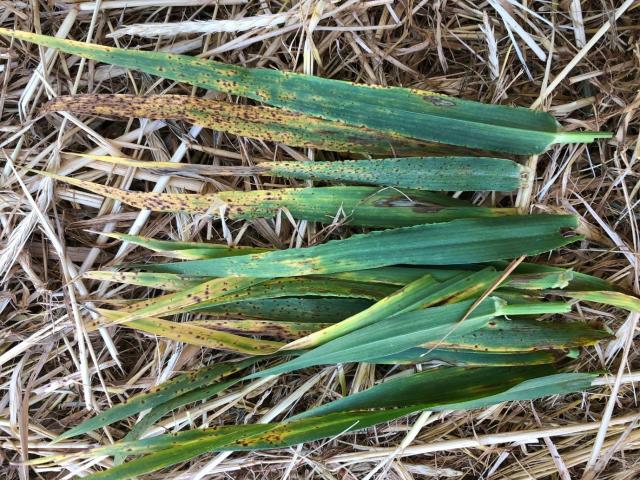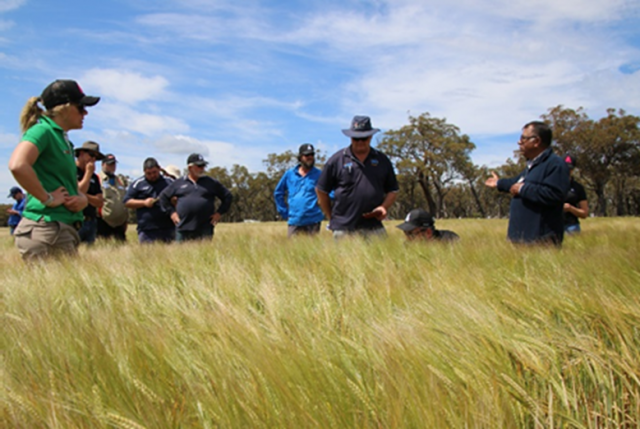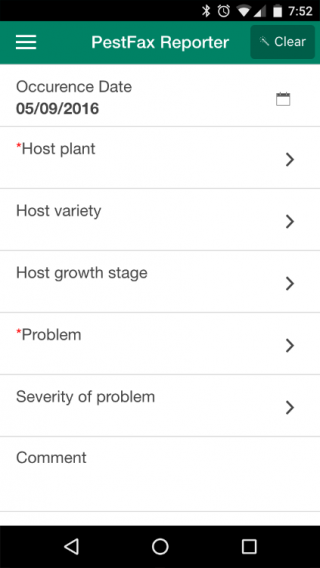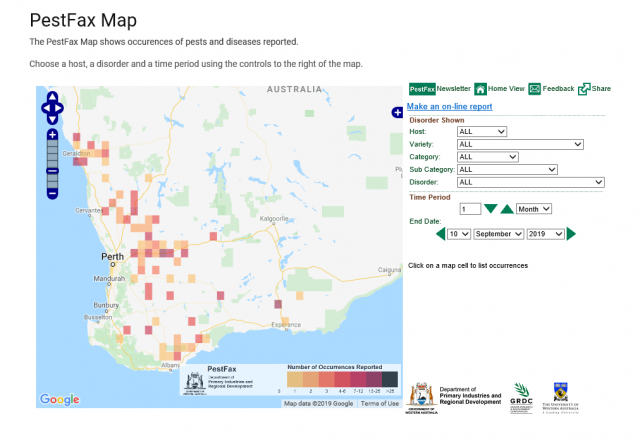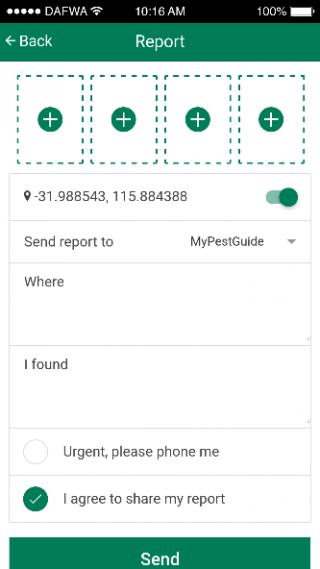Disease surveillance and reporting
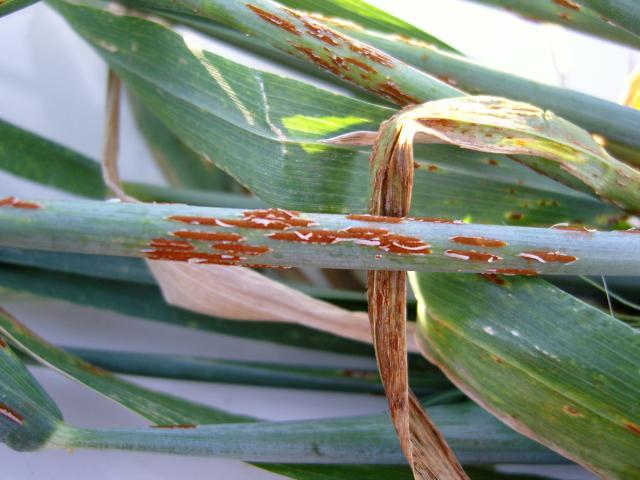
In the Western Australian grains industry, the cost of managing existing pests and diseases is greater than $0.5 billion per annum. There is also a risk of new pests and diseases entering, establishing and spreading in WA threatening productivity, profitability, market access, and sustainability. Improved surveillance and diagnostic strategies will minimise production and economic losses through increased understanding of drivers of disease and insect epidemics to enable better-informed decision making by grain growers on disease and pest control.
Surveillance and monitoring of crops across the WA grainbelt is also necessary to provide proof of freedom from exotic pests and diseases and to detect and identify any threats to a crop as quickly as possible to allow a rapid response to any incursions.
The Department of Primary Industries and Regional Development (DPIRD) plant pathology team carry out specific monitoring activities and coordinate with other research projects and industry to monitor the WA grainbelt for pest and disease outbreaks throughout the year. Crop diseases can have significant impacts on grain yield, grain quality and trade implications and so early detection is essential to appropriate management.
The agricultural sector relies heavily on reports from agronomists, consultants and growers of any unusual weeds or diseases in crops.
Exotic pathogens
Crop pathologists and entomologists maintain awareness of high priority exotic insect and disease threats to grain production. At any time they are in cropping regions they will monitor for the presence of any unusual or unexpected organisms. As a component of new GRDC funded surveilance, high priority pathogens have been identified in a list of exotic pathogens with significant production or trade implications for Australian and Western Australian grains industry and are specific targets of a new surveillance project co-funded with GRDC, to confirm proof of freedom from these diseases. Proof of freedom from these diseases has an important impact on trade.
The new pathogens to be added to the list of diseases specifically targeted are:
- Stem rust UG99 (Puccinia graminis f. sp. Tritici) pathotype Ug99 - www.agriculture.gov.au/pests-diseases-weeds/plant/ug99
- Barley stripe rust (Puccinia striiformis f. sp. Hordei) - www.planthealthaustralia.com.au/pests/barley-stripe-rust/
- Lentil anthracnose (Colletotrichum truncatum) - www.planthealthaustralia.com.au/pests/lentil-anthracnose/
- Wheat blast (Pyricularia graminis-tritici Pygt) - www.cabi.org/isc/datasheet/121970
- Barley stripe mosaic virus https://www.plantwise.org/knowledgebank/datasheet/10529
These diseases are not yet present in Australia and so a number of DPIRD staff have been trained in the recognition and biology of the pathogens. Training includes understanding of the most likely hosts, conditions favourable for disease, symptoms of the disease and where possible microscopic identification. Trained staff will supply reports and samples whenever they visit a host crop paddock, trial, NVT site or on a susceptible volunteer host.
At any time one of these pathogens / diseases or any other exotic disease or insect pest is suspected, either in the field or in a seed sample it is important to report it. Please take photos in the first instance, upload them using MyPestGuide (app or website) and/or contact the Pest and Disease Information Service (Exotic Plant Pest Hotline) on +61 (0)8 9368 3080. For more information, view the sending specimans for identification webpage. [see later in this newsletter for more details].
Ramularia Leaf Spot (RLS) detected through surveillance program
Ramularia leaf spot (caused by Ramularia collo-cygni) is a fungal leaf disease that can affect crops late in the season, with symptoms developing from flowering onwards. Following detection of Ramularia leaf spot in Tasmania in 2016 and an unconfirmed detection in WA in 2017, DPIRD plant pathologists carried out a targeted surveillance program in southern growing regions for the presence of this disease. The disease was identified in three locations in the Albany and Esperance port zones, the first record of the disease in WA.
Leaf and seed tests done as part of a new GRDC funded project with DPIRD leadership, will help determine whether the disease is present in the other mainland states and show the current distribution of Ramularia leaf spot within WA. It will also collect fungal isolates for further testing to determine whether they have altered sensitivity to the main three fungicide groups used in WA (QoL, SDHI and DMIs). DPIRD surveys of over 150 barley sites in 2019 has so far returned only four positive results, with three of these clustered around the South Stirlings and the other near York.
Fortunately most fungicides applied to control other foliar diseases on barley are also expected to give some control of ramularia. In 2018, an agronomy trial at Esperance subsequently found to be infected with ramularia showed a 6% yield increase with the application of fungicides at Z31, late elongation (Z37) and half head emerged (Z55). However, the major concern with ramularia is its ability to rapidly develop insensitivity to many fungicides, which has occurred in Europe and New Zealand. Fungicide group rotation is a critical component of preventing this from happening in Australia.
Endemic pathogens
Endemic pathogens are pathogens that are known to be present within the state and are seen more commonly in regional crops, for example yellow spot in wheat. By detecting these pathogens earlier, and communicating their presence, growers and consultants are warned to to be on the look-out for the disease.
Each year DPIRD researchers and technical staff conduct visual assessments and take plant samples from cereal, canola and pulse crops at head emergence, flowering and grainfill growth stages across the grain-belt to maximise the chance of detecting foliar diseases. The surveillance program is not specifically targeted to high disease risk zones but is stratified according to area of crops within designated port zones and the size of the zone. This surveillance program gives both seasonal updates of disease occurrence but also allows between season tracking of how disease prevalence changes.
Virus surveillance
Virus specific sampling is performed annually on both crop and non-crop hosts of plant viruses to determine the presence of various virus species. The primary goal of virus surveillance is to determine what viruses, both exotic and endemic, are present in the Western Australian (WA) region. Samples are taken from symptomatic plants, volunteer hosts and high risk environments.
Spore trapping
Spore traps are designed to collect airborne particles, including fungal spores, onto a tape or glass slide for later identification by visual or molecular methods. Dr Kith Jayasena from DPIRD Albany, has been monitoring a network of passive wind-vane spore traps in the Albany port zone for the past 7 years, and they will continue to be monitored as part of DPIRD’s disease surveillance program, as a method of early detection for disease in commercial crops. Slides from the spore traps were changed weekly and examined under a microscope for various fungal spores, with the emphasis in the Albany zone being on barley disease. Trap plots of disease susceptible varieties (eg. Baudin barley) sown adjacent to spore traps act as sentinel or indicator plot and are examined weekly for the expression of disease symptoms. Presence of identifiable spores of known crop pathogens can act as a warning for growers of disease risk and promote active monitoring of crops for presence of disease. The results from the presence of spores in spore traps are compared to onset of diseases in grower’s crops or in ‘trap plants’ planted near the traps. Spore trapping for BGM of lentils, using similar methodology, has also started in the Esperance region.
Spore traps can collect airborne fungal spores before the commercial crops get infected but the infection process and onset of disease in crops will be determined by the environmental conditions occurring at the time. For example, in 2017, even though powdery mildew and net blotch conidia were observed in spore traps at all locations, symptoms of the disease were only observed at three locations on unprotected trap plants. Therefore it is important to understand that spore trapping provides an indication of disease risk (that is presence of the pathogen) but that expression of disease will be facilitated by favourable weather conditions. Spore traps act as an indicator of risk and warning for close monitoring of crops for onset of disease.
| Airborne spores first detected in passive spore trap | |||
|---|---|---|---|
| BLR | PM | NB | |
| Kendenup West | 11 May | 2 Aug | 1 June |
| Tenterden | 26 Apr | 1 June | 3 May |
| Woogenilup North | 26 Apr | 28 June | 28 June |
| Takaterup | 19 Apr | 28 June | 21 June |
| Kojaneerup West | 19 Apr | 28 June | 21 June |
| Kojaneerup South | 19 Apr | 19 Apr | 26 Apr |
| Kuch Rd | 11 May | 27 July | 14 June |
| Pallinup | 26 Apr | 7 June | 26 Apr |
| Nayarlup | 11 May | 25 July | 26 Apr |
| Trap Plants (Baudin barley) Date symptoms detected | |||
|---|---|---|---|
| BLR | PM | NB | |
| Kendenup West | 21 June | ||
| Tenterden | 14 June | 20 Sept | |
| Woogenilup North | 21 June | 5 July | |
| Takaterup | 14 June | ||
| Kojaneerup West | 14 June | 27 July | |
| Kojaneerup South | 27 July | 17 Aug | 5 July |
| Kuch Rd | 5 July | ||
| Pallinup | 2 Aug | 9 Aug | |
| Nayarlup | 14 June | ||
PestFax Reporter and MyPestGuide Reporter - Which app do I use to report or diagnose plant diseases with?
When finding plant disease in crops and pastures DPIRD’s PestFax and MyPestGuide™ teams are keen to hear about it and assist with diagnosis if required. Both projects have apps that can be used to assist with plant disease identification, submission for diagnosis or reporting of the disease.
The PestFax Reporter and MyPestGuide Reporter apps have been previously discussed in the 2018 Protecting WA Crops Issue 11 PestFax Reporter and MyPestGuide Reporter - Which app do I use to report pests with?
Ultimately readers can be assured that the department is grateful to receive your reports and the PestFax and MyPestGuide™ teams do work together and make sure that your reports end up being delivered into the relevant project and followed up if necessary.
PestFax Reporter app and map
Growers and consultants can use the free PestFax Reporter to make quick reports, and request diagnoses, from paddocks of pests, diseases, weeds and other damage in broadacre crop and pastures. Up to three images can be attached to a report to assist experts with diagnosis or confirmation of the disorder. The PestFax Reporter app is designed for speed, tailored for crop and pasture conditions, Users can request if they want a department expert to reply via phone or email with a diagnosis and management advice, or not at all if no feedback is required.
Users should be careful to download the WA version of the app (PestFax Reporter) and not the eastern states version (PestFacts Reporter). The PestFax service is the WA delivery arm of the new GRDC co-funded IPMforGrains: Best Practice Insect Pest Management project.
The PestFax Reporter app works in conjunction with the PestFax map and PestFax newsletter.
Reports are displayed on the PestFax map to visually display insect, disease and weed occurrences in WA. For more information on this valuable tool refer to the 2019 PestFax Issue 4 article Do you use the PestFax map?
More detailed report information (occurrence, detailed disease descriptions, management advice etc) is extended via the weekly PestFax newsletter to approximately 1000 subscribers during the growing season.
For more information on this app and how to download it refer to the department’s PestFax Reporter page.
MyPestGuide Reporter app
MyPestGuide Reporter™ is a free photo based reporting app and community portal that allows members of the public to report any insect, disease, or weed in any habitat in WA (including households, other buildings, gardens, or public spaces).
MyPestGuide Reporter™ is flexible, allowing any situation to be described and is not restricted to broadacre crops and pastures.
Users can attach up to four photos to the report using the device’s camera, include location data using the device’s GPS and add additional information or questions in text fields.
Department experts identify the pest and provide a response with the identification and information on the organism directly to the reporter through the app. If the reporter has agreed to share their report, it will be included on the map on the MyPestGuide™ community website.
If a physical sample is required, users can generate a unique sample ID barcode through the app. This allows submitted samples to be tracked and assists with lab analysis and follow up.
MyPestGuide™ reports assist in the early detection of exotic pests and support Australia’s access to existing or new overseas trade markets. Every report helps the department maintain Western Australia’s pest-free status by providing evidence of freedom from exotic pests.
For more information refer to the department’s MyPestGuide Reporter page.
In addition to the reporting tool, the MyPestGuide™ family includes three field identification guides and a crop scouting tool. MyPestGuide Crops is a field identification tool available as an app or website and contains information and photos of 203 common and exotic grains pests.
DPIRD Diagnostic Laboratory Services-Plant pathology (DDLS)
DDLS provides critical disease diagnostics services for broadacre crops (cereals, canola and pulses), pastures and horticulture (ornamentals, nursery plants, amenity horticulture, turf, soil, fruits and vegetables).
The diagnostic team assists clients with on-farm decision-making to improve the productivity, quality and marketability of crops through correct disease diagnosis.
DDLS plant pathology services provides:
- routine plant disease diagnosis in plants, potting mix, soil and water
- nematode analysis of roots and soils for horticulture and broadacre crops
- plant virus identification
- specific disease testing for seed crops to meet export requirements
- plant pathogen testing to fulfil nursery accreditation and export requirements.
After diagnosis, we can direct you to specialists to:
- implement best practice pest and disease control
- reduce your use of incorrect or unnecessary chemicals.
For more information about plant disease and virus testing, sample submission forms and sampling techniques, contact DDLS Specimen Reception, ph: +61 (0)8 9368 3351 or email DDLS@dpird.wa.gov.au.

